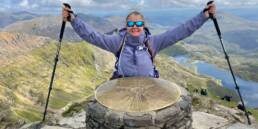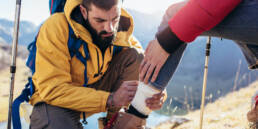Photo © Emma Frances Logan
Knowing what to wear to climb Snowdon is essential as getting it wrong can at best spoil your day and in the worst case scenario lead to much worse. But it’s really not that difficult if you follow a few simple rules. This guide is aimed at those new to mountain walking who might be venturing out on their first mountain day.
It’s good to remember that there’s no need to spend a fortune on top-end outdoor clothing. You’ll see people out in the mountains wearing waterproof jackets that cost £400+ and they are really good if you’re going to be spending day after day outdoors working in the rain. For most people the raincoat you’ve got in the cupboard will likely do you just fine.
One of the best tips we can give you is to visit your local outdoor shop. Whether it’s a little independent store in your town or a large chain such as Go Outdoors the staff will be well used to people asking questions about what they need for the outdoors so don’t be afraid to ask.
So here’s our guide to what you should wear to climb a mountain.
Feet
Starting from the bottom up you’ll need something comfy to walk in. Exactly what will depend on which mountain you’re going to be climbing, how long you think it’s going to take you and how much money you have. Very simply hiking boots are better than walking shoes and walking shoes are better than trainers but that’s not to say if you’ve got a good pair of sturdy trainers you won’t enjoy yourself … you just might end up with a blister and soggy feet if it rains.
If you plan to do more than a couple of day’s mountain walking then we recommend investing in a sturdy pair of hiking boots. They don’t have to be expensive and if you’re not sure which ones to choose your local outdoor shop will be able to help you decide and even fit them for you. Aim for something with ankle support and leather will tend to be longer lasting and more waterproof than fabric but do need a bit more caring for. TOP TIP – Visit an outdoor shop to get personal advice. They fit walking footwear every day and will be able to tell you exactly what you need.
Still looking after your feet socks are really important too. Whilst you can spend money on fancy walking socks for different climates a good pair of sports socks will do you fine. If you often get cold feet then wear thick socks but avoid wearing more than one pair of socks at a time as the friction will lead to blisters. TOP TIP – Pack a spare pair of socks in your rucksack in case the ones you’re wearing get wet or just to give you a fresh feel for the way down.
If you’ve bought new footwear try to wear them a few times around the house or on short, local walks before a big mountain day to ‘wear them in’ and make sure they’re a good fit.
Bottom Half
Walking trousers are great particularly the ones you can zip the bottoms off to turn into a pair of shorts as this gives you choices if the weather changes. They don’t have to be expensive and will make a real difference to your day. If you’re absolutely certain of the weather and have no other choices then tracksuit bottoms will do the job however jeans are really bad as if they get wet they become heavy and are slow to dry so these are an absolute no-no for any mountain day. TOP TIP – If you know it’s going to be a wet day and you have (or can borrow) a pair of waterproof overtrousers they’ll do a great job in keeping your warm and dry.
Underwear won’t be an issue for most – simply wear something comfy. If you have any sort of sports underwear then this is great and ones that ‘wick’ moisture away from your body are even better.
Top half
The key to your top half is layers as when climbing a mountain you want options – remember the temperature you start out with is likely to be very different to the temperature at the top of the mountain and you’re going to feel warmer walking uphill than you will coming down. So leave that bigger, heavy winter coat at home and instead wear a t-shirt, a fleecey top of some sort and a lightweight but warm jacket – that way you can easily add/remove layers as conditions change. TOP TIP – Pack an extra layer in your rucksack as a backup in case anything becomes wet or it gets really cold.
Essential to any day out in the UK is a waterproof jacket. Even if the sun’s cracking the flags as you set off and the forecast is looking tropical all day you never know when the British weather is going to turn. They don’t take up much space in your rucksack and are a great extra layer for the summit if it turns cold.
Finally remember to bring a hat and gloves. On a sunny summer’s day a sun hat or baseball cap will help protect you from the strong UV rays and for the other 360 days a year pack a woolly hat for extra warmth.
Accessories
You’re going to need something to carry your lunch in so a rucksack is best here. There’s no need for a huge expedition-size backpack – just something that you can get in what you need with you for the day. Most rucksacks aren’t waterproof so if yours doesn’t come with a rain cover (a little pull-out waterproof cover usually found at the bottom front of your bag) then you’ll need something inside to keep your stuff dry. Experienced mountain walkers will use small dry bags so they can sort the contents of their rucksacks but a big, strong black bin liner rolled over several times at the top will do the job nicely. TOP TIP – If you’ve bought a new rucksack wear it around the house before your mountain day so you can be sure it fits correctly.
If you’re worried about your knees then you may find walking poles useful particularly on your way down. ‘Jelly legs’ are a real problem for many and you’re more likely to have an injury on your descent due to fatigue. A head torch is also a valuable accessory to have with you particularly if you’re starting out in the dark or you’re walking in autumn/winter when the nights are drawing in.
Be sure to pack enough food and drink for the day and then extra snacks just in case. Remember you’re going to be burning a lot more calories than when you’re sat in the office so you’re going to need to eat and drink more than usual. A good sized water bottle (at least a litre and preferably double that) is essential and avoid fizzy drinks. TOP TIP – a bag of Jelly Babies will provide a great energy boost if needed and are always great to share around.
Your mobile phone is an essential piece of equipment to have with you on your mountain day. As well as being an obvious way to call for help if anything was to go wrong you can use the camera to capture those once in a lifetime memories and you’ll find lots of useful apps to help you enjoy your day. Remember to fully charge it before you leave the house in the morning. TOP TIP – invest in a power bank for extra battery life but ensure it’s fully charged too.
Finally pack a small, personal first aid kit along with any medications you take on a regular basis along with suncream, wipes and other things you might find useful on a day out.






